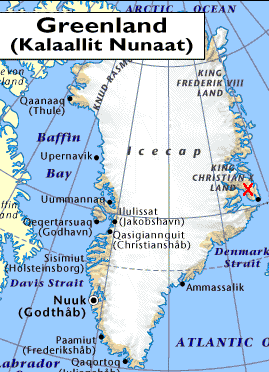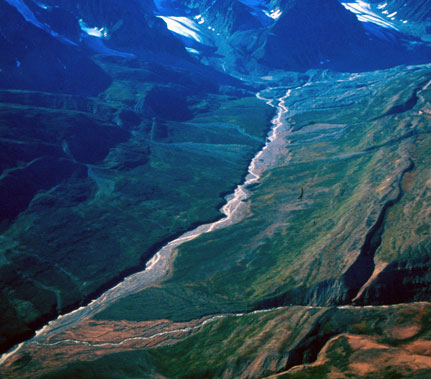This project is funded by the Comer Science and Education Foundation
Meredith Kelly (Lamont-Doherty Earth Observatory)
Brenda Hall (University of Maine)
August 14, 2004 to August 31, 2004



 After the successful mission of the Turmoilto Scoresby Sund, eastern Greenland, in 2003 it was decided that shock troops were needed on the ground to verify several working ideas developed from aerial surveys. The basic problem is the extent of glacier ice during the Younger Dryas and how much of a climatic change that extent represents. This separates into two problems 1) which of the numerous lateral moraines are truly Younger Dryas in age and 2) how large of a climate cooling is needed at that time. As is typical of many field problems the challenge is to demonstrate the age of the moraines.
After the successful mission of the Turmoilto Scoresby Sund, eastern Greenland, in 2003 it was decided that shock troops were needed on the ground to verify several working ideas developed from aerial surveys. The basic problem is the extent of glacier ice during the Younger Dryas and how much of a climatic change that extent represents. This separates into two problems 1) which of the numerous lateral moraines are truly Younger Dryas in age and 2) how large of a climate cooling is needed at that time. As is typical of many field problems the challenge is to demonstrate the age of the moraines.
For this first effort a relatively small, simple glacier draining off the southeastern side ofthe Stauning Alps was selected. The river flowing in this valley is the Gurreholm. It turns out David Sugden and Brian John had visited this area in the mid 1960's and studied the emerged deltas at the valley mouths. From their work and others it was deemed a safe bet that marine shells were in sufficient supply to verify or modify the existing uplift curve. A second, independent dating approach is necessary and for this exposure age dating of 10Be accumulating in quartz crystals was selected.
The team was three: Meredith Kelly, a newly appointed post-doc at Lamont, Brenda Hall, a newly appointed Assistant Professor at the University of Maine, and Tom Lowell an old fart from the University of Cincinnati. Meredith did the work of planning and obtaining all the necessary permits from the Danish Polar Center, a job ending up larger than  expected. She willbe responsible for generating the exposure age dates subsequent to the field season. Brenda was asked to draw upon her Antarctic experience and develop a new uplift curve from the radiocarbon dating of emerged shells. Tom was to carry the gun, pound rocks, and dig pits.
expected. She willbe responsible for generating the exposure age dates subsequent to the field season. Brenda was asked to draw upon her Antarctic experience and develop a new uplift curve from the radiocarbon dating of emerged shells. Tom was to carry the gun, pound rocks, and dig pits.
The team flew into Constable Pynt on 14 Aug 2004, moved to Gurreholm that night and began field work the next day. During the next two weeks we worked out of three camps along the valley sampling shells, rocks, and mapping moraines. Eventually we were able to collect some 40 shell samples, some 36 rock samples, and obtain preliminary measurements on former snowlines from three different moraine sets. It will take some time to get the chronological data back to verify the age of the moraines, but all indications are that we bracketed the Younger Dryas moraine(s) and can thus produce an estimate of the climate change around the Stauning Alps.
